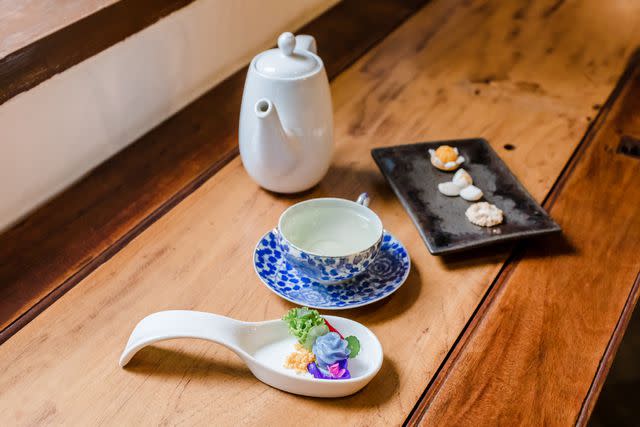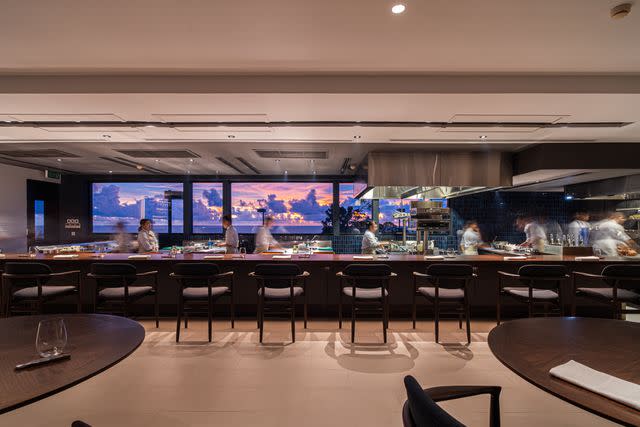Where and What to Eat in Phuket, Thailand, 'The White Lotus' Season 3 Film Location
Experience a noodle specialty, Thai royal tea desserts, and a Michelin-starred tasting menu in the vacation destination.

Courtesy of Tatonka
Thailand’s biggest island, Phuket is often equated with beach resorts. But its capital, Phuket Town, ignored by most tourists who stampede to the beaches (and most guidebooks), is a UNESCO City of Gastronomy, where distinctive food melds Thai, Chinese, and Muslim influences.
Thailand’s only Michelin-starred restaurant outside of Bangkok is on Phuket, a film location for The White Lotus Season 3, which airs in 2025, along with Bangkok and Koh Samui. An hour’s flight from Penang, Malaysia, or 1 1/2 hours from Bangkok, Phuket has a Buddhist temple with 36 golden Buddha statues, Wat Chalong, and a white alabaster hilltop Buddha statue almost 150 feet high. An estimated 70% of its people are of southern Chinese descent, since thousands emigrated for Phuket’s tin mining era in the late 19th century and married Thai women. Though Thailand was never a colony of China or Portugal, Sino-Portuguese architecture, a fusion of Chinese and European design elements, became very popular in Phuket, similar to what you see in Penang. The island is packed with Sino-Portuguese shophouses in pastels like pink, aqua, and yellow.
Here's how to plan a visit around the local food.
Try Hokkien mee
One Phuket specialty, Hokkien mee, is a southern Chinese noodles and pork dish reinvented for the Thai palate with seafood and black pepper gravy. Praised by many for the best Hokkien mee in Phuket Town since the current owner’s grandfather opened it in 1946, Mee Ton Poe serves a stir-fry of fat noodles heaped with pork, shrimp, squid, and pork sausage in pepper gravy, cooked over a charcoal stove, at the no-frills spot with plastic stools at Clock Tower Circle. But many locals claim the best is at Ko Yoon, a hole-in-the-wall where it’s the only (ridiculously cheap) dish served — either in broth or dry noodles with broth on the side, with generous toppings of sliced pork, fish balls, and greens in a deeply flavorful broth. I passed by this ultra-cluttered small room packed with tchotchkes and family photos by Fountain Circle several times without knowing food was served in the back, until I booked A Chef's Tour.
Take a Phuket food tour

Courtesy Prem Dessert Bar
From street food snacks to a stylish, contemporary dessert café in a white Sino-Portuguese shophouse with egg yolk-yellow trim, I sampled 15 tastes on my half-day tour with Lucky. At Prem Dessert Bar, I tasted tiny Thai royal tea desserts, an inch or so big, to experience a lost culinary art rare in Thailand today, since they take hours to meticulously make by hand, the process can’t be automated, and the skills required are vanishing. Chef/owner Papatsarin “Jinny” Pattrarameteesate spotted the recipes in her grandmother’s 80-year-old cookbook, found with equally as old brass molds while she was renovating her family’s shophouse. Enchanted, she began to re-create the treats, often in pastels that match the shophouses outside, which bear poetic names like "Moon Floating Among the Clouds" (bulan dan mek), a round dark-blue snack — inspired by a song King Rama II wrote after dreaming of the full moon drifting through clouds — and “Golden Rain Stone” (hin fon thong), a gold-leaf-covered, small, black treat, that Thai soldiers once carried for energy due to its high sugar content and portability. Served at round marble tables, the treats are also beautifully packaged for takeout.
At Cham Cha Market, an outdoor market selling mostly ready-to-eat foods, I munched on popiah sod, a flour wrapper with a grilled pork, peanuts, beansprouts, small dried shrimps, and lettuce filling doused in tangy tamarind sauce — so popular, its vendor sells about 1,000 a day. A perpetual motion machine, he’s a blur of continuously laying out wrappers, filling, and rolling them. Another find at Cham Cha is a betel leaf-wrapped sweet, sour and crunchy filling of toasted coconut, cubed limes, crushed peanuts, shallots, cubed ginger, and dried shrimps in palm sugar sauce, called miang kham.
Crabmeat curry in coconut milk (kang-puu) is a signature dish at Raya, a beloved favorite in a pale yellow 1909 Sino-Portuguese house with green shutters, tile floors, stained glass inserts and multiple rooms that opened in 1994. Its huge menu also features fried shrimp in tamarind sauce and lemongrass, roast duck curry, steamed pork with pepper and garlic, and tiger shrimp so large, you need just two for dinner.
Related: Today's Thai Chefs Bring a Fresh Mindset to Bangkok's Food Scene
Splurge on a Michelin-starred meal

Courtesy of PRU
About 15 miles west of Phuket Town, one-Michelin-starred PRU offers Dutch-born executive chef and co-owner Jimmy Ophorst’s tasting menu of about nine small exquisitely presented dishes for dinner next to Trisara, a luxury pool villa beach resort on Phuket’s west coast. All ingredients are sourced from Thailand, much of it from the restaurant's nearby organic farm. One of Ophorst’s favorite dishes is his durian and caviar, where he roasts the fruit (famously smelly when raw) for hours over a wood fire for a caramelized, smoky flavor, turns it into a mousse; pairs it with local caviar; and finishes it with marinated mulberries, melon vinegar, shiso leaf oil, and basil flowers. “It brings an element of scare to the dining table, something bold and special at once, a harmonious balance of salty and sweet,” Ophorst says. “It also shows what you’re up for at PRU.”
Another unexpected combo: the squid and blue cheese, where he prepares the squid in four ways, from a confit in XO oil, raw and marinated with organic lemon skin, a squid “ham” smoked and aged for a month, and caramelized in a sauce that uses blue cheese from Chiang Rai, paired with sour herbs. Other dishes at PRU include black cod in fermented tea leaf oil, topped with smoked cod roe; and fennel marinated in vanilla butter, wrapped in vanilla leaf, glazed with passionfruit reduction, and served with a sauce of calamansi juice and oil from wan sao leang leaf, an herb used in Chinese traditional medicine. The restaurant reopened in November 2023 in a new sleek contemporary space, where the chef’s table with a backdrop of big picture windows allows for spectacular sunset views on the Andaman Sea. Lunch is also served on Friday and Saturday.
Embark on a dining adventure

Courtesy of Tatonka
Also outside town, popular since it opened in 1996, Tatonka serves “globetrotter cuisine,” with an imaginative menu that reflects the life of Harold Schwarz, its Bavarian chef/owner, an expat in Thailand for 25+ years who worked in European ski resorts, Hawaii, California, Bermuda, and Colorado. A very varied menu features many tapas-sized appetizers with Thai, Italian, and Mexican influences, like crispy cones of larb gai (minced chicken with mint, lime, and shallots), duck cigars, and Saigon beef.
Whether you dine on the lush plant-filled patio or indoors, you’ll be distracted by the Native American-inspired deer, moose, and horse designs on the canvas ceiling and walls, which Schwarz hand-painted. Named after the Plains Indian word for “buffalo” (as fans of Dances with Wolves may recall), his eatery is a 15-minute walk from Laguna Phuket, a multi-resort complex on Bang Tao beach that includes Banyan Tree, Dusit, and Angsana hotels.
Related: This Treepod Restaurant in Thailand Has Ziplining Servers and Unreal Views
“I grew up watching American Westerns about cowboys and Indians, and reading books by Karl May about them. In Colorado, it all came together,” said Schwarz when we met, alluding to the German novelist who wrote about the West from prison but never saw it. (Schwarz died suddenly in January, but his team is following his recipes and vision, his wife, Khun Yen, said.)
For more Food & Wine news, make sure to sign up for our newsletter!
Read the original article on Food & Wine.


